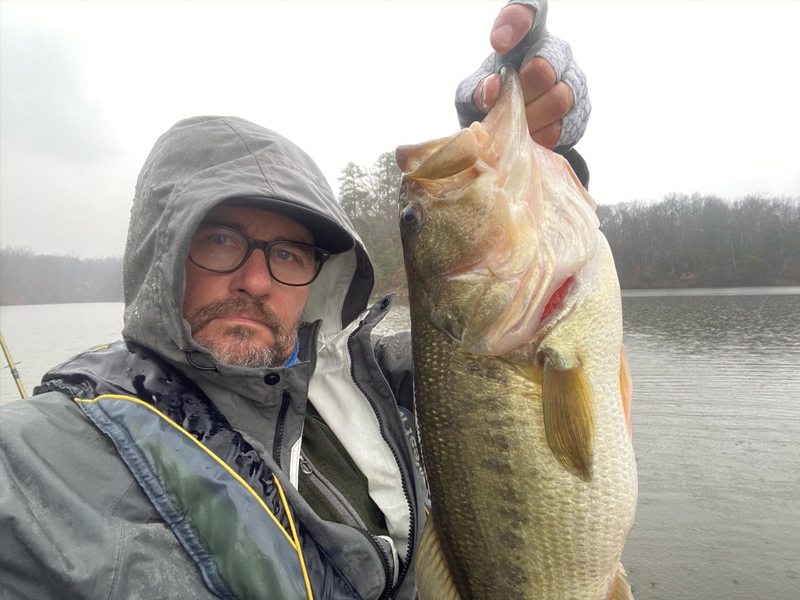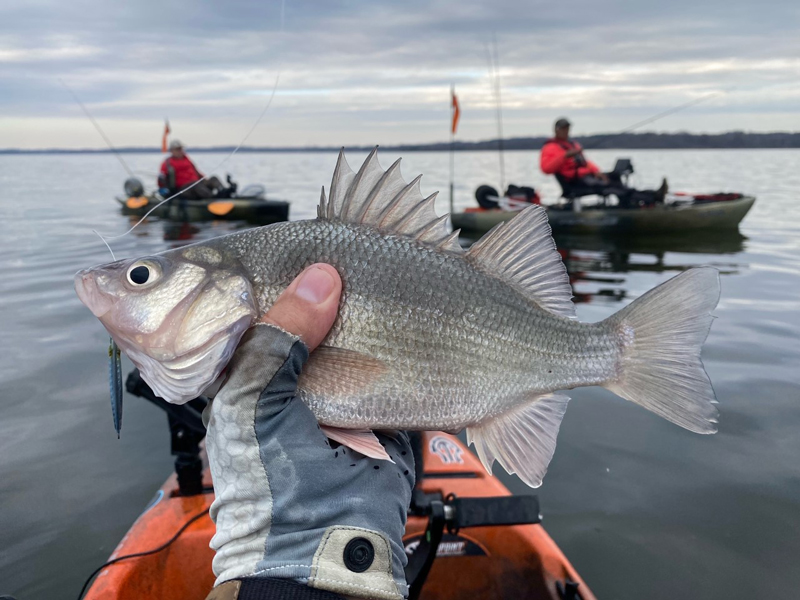Winter is here and most anglers focused on Chesapeake Bay fishing have hung up their rods and winterized their boats for the season. But a few of my fishing buddies and I are checking our tackle, dusting off our cold weather gear, and making a mental list of places we plan to fish over the next few months. I’ll be fishing lakes, the millponds on the Eastern Shore, and several of the rivers, plus any other open water to catch and target a variety of species of fish — kayak fishing or fishing from a small Jon boat that doesn’t have to be winterized is the perfect way to keep getting out on the water during the winter months.

There are a number of fish species that can be found during the cold months in the region, such as largemouth bass, pickerel, white perch, and black crappie, just to name a few. But fish react to the water temperature they are in. When it’s sunny out and the water is warm they move faster than when it’s cloudy and the water is cold. So slow your presentations down, and adjust throughout the day as needed. Also remember that many waterways have very clear and clean water during winter as compared to the summer months, so use lighter weight fishing line and leaders to reduce their visibility.
The type of fishery is a player here too. A millpond on the Eastern Shore will need to be approached differently than a reservoir, and some of the millponds will need to be fished differently than others just a few miles away. Keep in mind that a millpond will normally have water no deeper than eight to 10 feet, and that the deeper water will be near the dam. I look for structure along the shoreline and target it, but there will be times when the middle of the pond will produce more fish than the shoreline. This is because the millponds are basically shaped like a sheet pan, the same depth the entire width of the lake. Fish in these ponds will patrol and hunt bait on a warm day and they will stay put on colder days waiting to ambush prey.
As for reservoirs, fish will move to shallower water, following the bait, if there has been a string of sunny warm days in a row. But they may be sitting in 20 feet of water along an old river channel on very cold days.
Winter Largemouth Bass
I just love to hunt largemouth bass in the cold because they provide a challenge that most other fish don’t. And I catch my biggest bass during the winter months! So let’s talk about largemouth bass. They can be almost anywhere in a lake or pond, from a shallow bay to the deepest water in the lake. Here is what you need to keep in mind when you head out for a day of winter bass fishing.
- Weather Patterns – If it has been warm and sunny for a few days head for shallow water, throwing inline spinners, spinner baits, jerk baits, and paddletail jigs. As the day progresses and the shallow water warms it draws in baitfish and the bass are on the move to hunt them.
- Types of Fisheries – Eastern Shore millponds have big bass and plenty of them. Look for surface action from bass feeding on baitfish, normally between 9 a.m. and 11 a.m. on warm days. This is the time of day when the water has started to warm and the baitfish are on the move.
- Time of Day – I have noticed that I am catching more bass on the millponds between 9 and 11 a.m. but I’ll continue to work the pond throughout the day, shifting areas of focus while checking for fish that have moved to structure or shade as the sun rises, and deeper water along the dams on very sunny calm days.
The Chain Gang: Winter Pickerel
My second favorite fish to hunt during the winter is chain pickerel. As the water cools these fish get very active.
- Weather Patterns – You can catch pickerel on almost any day during the winter. It seems to me that it is harder to catch on a nice sunny day, however, and a cloudy day is best. Effective baits are inline spinners, jerk baits, and — often the best bait for winter pickerel — a minnow on a jig a foot or so under a bobber.
- Types of Fisheries – Again, millponds are excellent for fishing for pickerel. But don’t just concentrate your fishing along shoreline structures. Turn your back to the shoreline, and take your cast towards the middle of the millpond or lake because in the millponds they seem to simply be sitting in wait for an unsuspecting baitfish to pass by along a dead or dying grass bed or fallen tree. In reservoirs the same can hold true. On St Mary’s Lake, for example, I find the biggest winter pickerel on large shallow flats near remaining grass, drop-offs, and other structures. If you are fishing a tidal river such as the Severn or Magothy, look for pickerel around the docks, along riprap, and on shallow flats. When the tide recedes look for them along the channel edges.
- Time of Day – I seem to have my best luck early in the morning but on the rivers, the tide can play a role here. On a moving tide they will be more active, as most other tidal fish will. At the bottom of the tide, find them in the channels, on a high tide look around docks with moving water.
Winter White Perch

Let’s talk about winter white perch, but be forewarned, this isn’t always an easy one…
- Weather Patterns – Winter perch are usually found in deep tidal waters, so I try to go out only on low wind and calm water days.
- Types of Fisheries – I’ll be targeting… Okay, I’ll come clean here — I only fish the Patuxent River for them in the winter. I’m familiar with the water, my launch, and the holes I fish. But it’s a sure bet that the same type of water on another river, be it the Potomac, Choptank, or the like, will produce too. I look for holes that are 50 to 70 feet deep. Then I look for the fish to be stacked up, which looks like a massive bait ball on the meter. I will then position my kayak over the marks and drop a very small metal jig straight down into the fish. A slow quick jigging pattern usually produces bites. You may have to change up the pattern now and then too, and use more of a slow-pitch jig method where you drop the bait, give a quick snap, and follow the bait down with the rod tip. Make a quarter or less turn on the reel’s handle during the drop cycle. Then repeat until you get bit, working your way up through the water column. The bite will come on the drop of the jig. Try various types and colors of small jigs, too; you’ll catch a lot of perch on a blue colored metal jig.
- Time of Day – When the sun is out and it has warmed up some is the best time for this gig. Big water can have some very cold days.
Crappie in the Chill
Winter black crappie? Talk about some good eating, these fish taste great!

- Weather Patterns – As with white perch, try to find a day that is calm and sunny, but the weather doesn’t have to be perfect to hunt for crappie.
- Type of Fisheries – I find winter crappie fishing best in reservoir impoundments. There aren’t many that are open year-round, but St Mary’s Lake in Southern Maryland and Lake Anna in Virginia are, and they both produce winter black crappie. Use your meter to find schools of fish in water about 15 feet or deeper, then drop a micro-jig into the school. On a windy day micro-jigs will just drift behind the boat, so you’ll have to go heavier or use a split shot above the jig to get it down into the water column. I catch more fish on a chartreuse micro jig than any other color. Once I have dropped my jig into the fish I’ll let it rest for a few seconds. As the boat drifts with the wind, I will very slightly and slowly jig the bait up and down. When it’s a little windy and there is a slight chop on the lake you can drop two jigs over the edge of the gunnel and simply let the boat do the jigging for you. Minnows will work here as well.
- Time of Day – You can hunt crappie all day long, as mentioned above they will sit in suspended schools in deep water. Once you find them on your meter and nail down an effective bait, time of day doesn’t seem too critical.
There are other fish species to target throughout winter, too, but for all of them keep the basics in mind, and go slow with your lures. Also remember that live bait such as minnows will commonly produce more fish than artificial baits. Mix it up and experiment with your offerings and your presentation, too.
A final thought: don’t fish on windy days, or after a storm due to the rainfall making rivers and creeks unsafe. Always have a float plan and inform someone of the time that you’ll be on and off the water, then let them know via a phone call or text when you’re back on land. This way if they don’t hear from you they know to call, and if you don’t answer they can seek out help from the authorities. Stay safe out there — winter fishing in kayaks and small boats does have an element of danger to it.
-By Eric Packard
See Paddler’s Edge: Winter Kayak Safety for more information on cold-weather fishing safety.